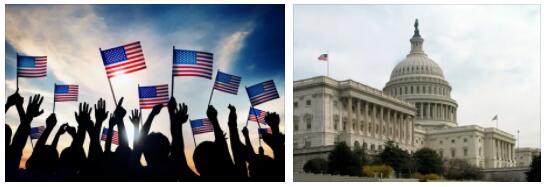Politics
The United States is a federation of 50 states, plus some other dependent entities, with a total area of nearly ten million square kilometers. The states are distributed almost entirely on the continent of North America, except for Hawaii, which geographically speaking is located in Oceania. The city of Washington, in the District of Columbia is the seat of the federal government.
Additionally, the United States has dependencies that are euphemistically defined as “associated free states.” They are not considered part of the country, but since they do not have diplomatic representation, currency, or their own defense, they are not independent states either. The Puerto Ricans are US citizens legally but are deprived of many rights, Puerto Rican political prisoners there to oppose this situation and others have been killed for the same reason. The United States does not consider them colonies, although they are listed in the UN Decolonization Charter and their situation is the result of the domination and repression imposed on these peoples throughout their struggle for independence.
Economy
The United States has a capitalist mixed economy, which is fueled by abundant natural resources, a developed infrastructure, high productivity, and the way it benefits from military aggression and political dominance over part of the world.
According to the International Monetary Fund, the GDP of the United States is more than $ 14 trillion dollars [28] and constitutes more than 25.5% of the world gross product at market exchange rates and more than 19% of the gross product world in purchasing power parity (PPP). It is the largest national GDP in the world, being lower than the combined GDP of the European Union and its PPP in 2006. The United States ranks eleventh in the list of countries by nominal GDP per capita and eighth in the list of countries by GDP at PPP per capita values. The United States is the largest importer of goods and the third largest exporter. Canada, Mexico, China, Japan and Germany are its main trading partners. The main export product is electrical machinery, while vehicles are the main import. The national debt is the largest in the world; equivalent in 2005 to 23% of the world total.
The United States has rich mineral resources with extensive deposits of gold, oil, coal, and uranium. Agricultural industries are the country’s main producers of corn, wheat, sugar, and tobacco, among other productions. The manufacturing sector produces, among other things, cars, airplanes, weapons and electronics. The largest industry is now the service sector in which about three-quarters of residents work. Economic activity varies a lot in different regions of the country.
Several countries have linked their currency to the United States dollar (such as the People’s Republic of China), and others have adopted it as their own currency, such as Panama, Ecuador and El Salvador, for example, which has benefited an economy that is currently every increasingly vulnerable and is affected by the questioning of the dollar as an international currency.
In 2003, the United States ranked as the third most visited tourist destination; its 40.4 million visitors are less than the 75 million in France and the 52.5 million in Spain.
The budget deficit of the United States closed in January 2011 at 49,800 million dollars, 200 million more than in the same month of 2010. According to data from the United States Department of the Treasury, public spending was set at 276 thousand 300 million dollars [29] .
Demography
The 17 of October of 2006, the Census Bureau of the United States estimated the population of the country in 300,000,000. [30] This figure included 12 million illegal immigrants. [31]
The United States is ethnically composed of 74.7% (224.1 million) White, 12.1% (36.3 million) African American, 4.3% (12.9 million) Asian, and 0.8% (2.4 million) Amerindians. People of other races constitute 6.0% (18 million) and others with two or more races constitute 1.9% (5.7 million). Another statistic shows white people from Europe or descendants of Europeans, constituting 66.8% (200.4 million) of the total population, while the Latino population of any race makes up 14.5% (43.5 million) of the total population. Hispanics are the largest minority today.
The average life expectancy at birth in the United States is 77.1 years (80 years for women and 74.4 years for men). In 2003, the population under 5 years of age represented 6.8% (19,769 million) of the total compared to 12.4% (35,919 million) of those over 64 years of age. The majority of the population is female.
In 1996, they prohibit female genital mutilation and in 2012 they prohibit taking girls outside the country. [32]
According to educationvv, the population density in the United States was 32 people per square kilometer in 2004. The highest population density is in the northeastern United States, between the Great Lakes and the Atlantic Ocean. There are located several of the largest American cities, such as New York, Chicago or Philadelphia. This is the oldest area where the first English colonies were established from which the United States was formed. Another large concentration of the population is found on the west coast, in the state of California, where cities such as Los Angeles, San Francisco and San Diego are located.
Anti-immigrant laws
Recently, the state of Arizona passed an openly xenophobic law promoted by Arizona Senator Russell Pearce, who has a long association with white supremacy and anti-immigrant groups. The bill was approved by both houses of the state legislature, controlled by Republicans with Democrats voting against. The law allows anyone to be searched if a police officer suspects that he is an illegal immigrant, and makes it a crime not to carry identity documents. Since in Arizona almost all illegal immigrants are dark-skinned and come from Mexico, the law practically orders the police to arrest people for carrying their faces. Or by ” breathing being of Mexican descent, “as one local politician described.
